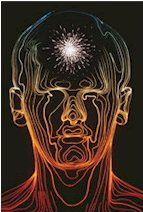 The human mind, according to neuroscientist Marvin Minsky, in all its complexity can be built up, layer by layer, from the interactions of agents, or functional subroutines.
The human mind, according to neuroscientist Marvin Minsky, in all its complexity can be built up, layer by layer, from the interactions of agents, or functional subroutines. This so-called 'society of mind' theory views the human mind and all other naturally evolved cognitive systems as a vast society of individually simple processes known as agents. These processes are the fundamental thinking entities from which minds are built, and together produce the many abilities we attribute to minds. The great power in viewing a mind as a society of agents, as opposed to as the consequence of some basic principle or some simple formal system, is that different agents can be based on different types of processes with different purposes.
It's been said that consciousness is merely the front-end of our brain that gives cohesion to all the processing that's done in the background. It it weren't this way, it would be impossible for us to retain a unitary sense of self and a firm grasp on reality.
In other words, there's a whole lot happening in our noggins that we're utterly oblivious to -- sort of what Freud referred to as the subconscious or unconscious mind, but it's a lot more complicated than that. Consciousness is more like an orchestra conductor that's unifying the society of mind that exists in the brain's various functions.
As proof -- that consciousness provides us with a limited window into the brain's workings -- there is a bizarre phenomenon known as blindsight that beautifully illustrates this.
Blindsight is the condition where some blind people are unconscious of incoming visual stimuli but are nonetheless able to guess with startling accuracy the details of what they're being exposed to.
Visual processing in the brain goes through a series of processing stages. Destruction of the first visual cortical area, the primary visual cortex (or V1), leads to blindness in the part of the visual field that corresponds to damaged cortical representation.
Although individuals with damage to V1 are not consciously aware of stimuli presented in their blind field, scientists showed in the early 1970s that if forced to guess about whether a stimulus is present in their blind field, such as an 'X' or 'O', they do rather better than chance -- upwards of 70% accuracy in some studies which is far above any statistical anomaly.
What's likely happening is that the visual data is being received through the retina and is actually hitting the brain's cortex, but the translation to consciousness is getting garbled and lost. More technically, the residual preformance of people exhibiting blindsight is due to preserved pathways into extrastriate cortex that bypass V1.
As this condition shows, being aware of doing something is distinguishable from doing something, and that areas of the brain underlying the experience of doing at least some things are distinct from those needed to actually do those things.
Tags: blindsight, visual impairment, neuroscience, society of mind, philosophy of mind, consciousness.

No comments:
Post a Comment